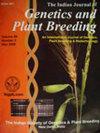Development of chloroplast microsatellite markers in Capsicum: Insight into evolution of Bhut Jolokia - a clad of ghost chilli landraces
IF 1
4区 生物学
Q3 PLANT SCIENCES
引用次数: 0
Abstract
In the present study, a total of 27 chloroplast specific SSRs (CpSSR) have been identified in the chloroplast genome of Capsicum annum L. The frequency of the SSRs was about one in 5.7 kb of the chloroplast genome. Out of 27 SSRs, 26 were mono-nucleotide repeats of A/T and one was a trinucleotide repeat (TTA). Further a set of seven markers were validated by genotyping 48 capsicum accessions comprising of cultivars from five different species and landraces of unknown identity. The seven SSR markers generated a total of 27 alleles among 48 samples used in this study. The size of the amplicons varied from 161 bp (CaCpM22 and 26) to 339 bp (CaCpM06). The polymorphic information content (PIC) value for the set of the primers used ranged from 0.11 to 0.48 with an average of 0.33. The number of alleles for markers ranged from three to six with an average of 3.28 alleles per marker. The phylogenetic analysis of the chilly accessions showed that the Bhut jolokia land race is clustered along with the C. frutescence indicating the it’s probable parentage. The chloroplast genome based SSR markers identified in the present study can be further used for the marker-assisted genomic studies辣椒叶绿体微卫星标记的发展:鬼辣椒地方品种Bhut Jolokia的进化
本研究共在辣椒叶绿体基因组中鉴定出27个叶绿体特异性ssr (CpSSR),频率约为1 / 5.7 kb。在27个SSRs中,26个是A/T的单核苷酸重复序列,1个是三核苷酸重复序列(TTA)。通过对来自5个不同品种和未知地方品种的48份辣椒材料进行基因分型,验证了7个标记的有效性。在本研究使用的48份样品中,7个SSR标记共产生27个等位基因。扩增子的大小从161 bp (CaCpM22和26)到339 bp (CaCpM06)不等。引物的多态性信息含量(PIC)值在0.11 ~ 0.48之间,平均为0.33。每个标记的等位基因数为3 ~ 6个,平均为3.28个。系统发育分析表明,山核桃陆生人种与山核桃陆生人种聚集在一起,表明山核桃陆生人种可能是其亲本。本研究鉴定的基于叶绿体基因组的SSR标记可进一步用于标记辅助基因组研究
本文章由计算机程序翻译,如有差异,请以英文原文为准。
求助全文
约1分钟内获得全文
求助全文
来源期刊

Indian Journal of Genetics and Plant Breeding
PLANT SCIENCES-
CiteScore
1.80
自引率
10.00%
发文量
0
审稿时长
6-12 weeks
期刊介绍:
Advance the cause of genetics and plant breeding and to encourage and promote study and research in these disciplines in the service of agriculture; to disseminate the knowledge of genetics and plant breeding; provide facilities for association and conference among students of genetics and plant breeding and for encouragement of close relationship between them and those in the related sciences; advocate policies in the interest of the nation in the field of genetics and plant breeding, and facilitate international cooperation in the field of genetics and plant breeding.
 求助内容:
求助内容: 应助结果提醒方式:
应助结果提醒方式:


